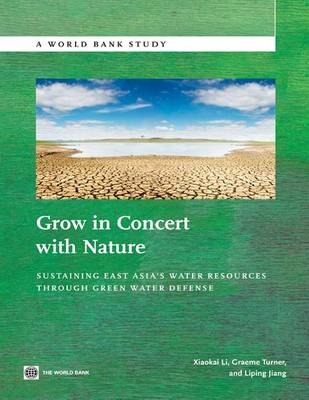
Grow in Concert with Nature
Sustaining East Asia's Water Resources Management Through Green Water Defense
Seiten
2012
World Bank Publications (Verlag)
978-0-8213-9588-2 (ISBN)
World Bank Publications (Verlag)
978-0-8213-9588-2 (ISBN)
Water scarcity is increasingly becoming a threat to water security in different countries or areas of East Asia, driven by water over-withdrawal and pollution, and aggravated by climate change and variability. The “Green Water Defense in East Asia” study, as part of the driver for green growth in the water sector of East Asia region, seeks to find a sustainable solution to this challenge.
Water scarcity is increasingly becoming a threat to water security in different countries or areas of East Asia, driven by water over-withdrawal and pollution, and aggravated by climate change and variability. The `Green Water Defense in East Asia’ study, as part of the driver for green growth in the water sector of East Asia region, seeks to find a sustainable solution to this challenge. The concept of Green Water Defense (GWD) is developed building on such principles as `live and build with nature’, `green adaptation’, `produce more with less’ and `low impact development’, etc. It is defined by the authors as `Green Water Defense (GWD) is an adaptive management philosophy and approach which seeks to spatially integrate natural forces and artificial interventions, and to balance incentive-based and supply-driven measures, with minimum footprints and externalities in providing water services and managing related climate risk.’ This report provides a brief account of the water resources and climate trend in the region, puts forward a conceptual framework of GWD based on a model of three spatial layers, namely, ecological base layer, an occupation (or land and water use) layer and an infrastructure (network) layer in the middle. The GWD serves as the media to integrate the interactions among three layers such that the water resources development and management are sustained. Based on the GWD concept framework, a menu list of GWD measures are formulated, and a set of emerging best practices for adaptive water scarcity management are identified through case studies (Australia, Israel, Spain and China). In an effort to apply the GWD concept and approach in East Asia, the report depicts a roadmap, with a general process, focus for different spatial scales and a practical example to illustrate where to start and how to apply these best practice approach and GWD measures in addressing water scarcity management issue in a client country.
Water scarcity is increasingly becoming a threat to water security in different countries or areas of East Asia, driven by water over-withdrawal and pollution, and aggravated by climate change and variability. The `Green Water Defense in East Asia’ study, as part of the driver for green growth in the water sector of East Asia region, seeks to find a sustainable solution to this challenge. The concept of Green Water Defense (GWD) is developed building on such principles as `live and build with nature’, `green adaptation’, `produce more with less’ and `low impact development’, etc. It is defined by the authors as `Green Water Defense (GWD) is an adaptive management philosophy and approach which seeks to spatially integrate natural forces and artificial interventions, and to balance incentive-based and supply-driven measures, with minimum footprints and externalities in providing water services and managing related climate risk.’ This report provides a brief account of the water resources and climate trend in the region, puts forward a conceptual framework of GWD based on a model of three spatial layers, namely, ecological base layer, an occupation (or land and water use) layer and an infrastructure (network) layer in the middle. The GWD serves as the media to integrate the interactions among three layers such that the water resources development and management are sustained. Based on the GWD concept framework, a menu list of GWD measures are formulated, and a set of emerging best practices for adaptive water scarcity management are identified through case studies (Australia, Israel, Spain and China). In an effort to apply the GWD concept and approach in East Asia, the report depicts a roadmap, with a general process, focus for different spatial scales and a practical example to illustrate where to start and how to apply these best practice approach and GWD measures in addressing water scarcity management issue in a client country.
| Erscheint lt. Verlag | 30.7.2012 |
|---|---|
| Verlagsort | Washington |
| Sprache | englisch |
| Themenwelt | Sachbuch/Ratgeber ► Natur / Technik ► Natur / Ökologie |
| Sachbuch/Ratgeber ► Natur / Technik ► Naturführer | |
| Naturwissenschaften ► Biologie ► Ökologie / Naturschutz | |
| Naturwissenschaften ► Geowissenschaften ► Hydrologie / Ozeanografie | |
| Sozialwissenschaften ► Politik / Verwaltung ► Staat / Verwaltung | |
| Technik ► Umwelttechnik / Biotechnologie | |
| Wirtschaft ► Betriebswirtschaft / Management ► Rechnungswesen / Bilanzen | |
| Wirtschaft ► Volkswirtschaftslehre | |
| ISBN-10 | 0-8213-9588-2 / 0821395882 |
| ISBN-13 | 978-0-8213-9588-2 / 9780821395882 |
| Zustand | Neuware |
| Haben Sie eine Frage zum Produkt? |
Mehr entdecken
aus dem Bereich
aus dem Bereich
über 500 faszinierende Gesteine, Minerale, Edelsteine und Fossilien
Buch | Hardcover (2023)
DK Verlag Dorling Kindersley
26,95 €
Familien und Gattungen einheimischer Pflanzen
Buch | Hardcover (2022)
Haupt Verlag
64,00 €
vollständig aktualisierte Neuausgabe mit den zusätzlichen …
Buch | Softcover (2023)
Westend (Verlag)
22,00 €


